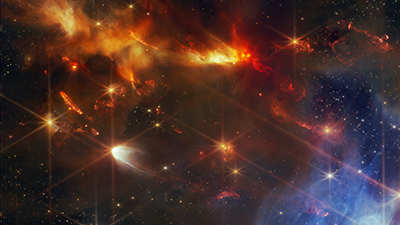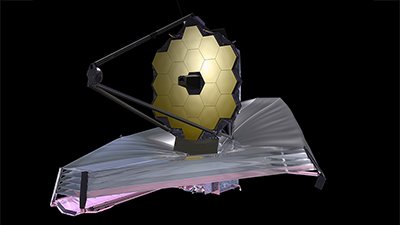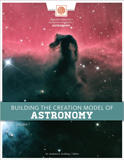
Evolutionists Can’t Adequately Explain These Beautiful Astronomical Objects
Double Stars—Double Glory for Their Creator
When I was a boy, my grandmother gave me a beautifully illustrated book about stars and the universe. One of its most memorable pictures was a double-star system. It was beautiful, but strangely, it was also scary. The stars orbited each other very closely. They had different sizes and colors. One was yellow like the sun, the other pale blue. Through gravity, they bulged toward each other and exchanged hot gas in a fiery embrace. I sensed they would be beautiful to view from afar but doubly dangerous for an orbiting planet or spacecraft up close. The caption said, “The variety of stars . . . is further enriched by coupling, tripling, or clustering. Only one in four stars travels alone.”1
This means probably more than half of the myriads of stars in the universe are double or multiple systems in gravitational interaction, with stars orbiting each other.
Estimates of the surprising commonness of multiple star systems vary, but they currently range from about half to two-thirds of all stars. This means probably more than half of the myriads of stars in the universe are double or multiple systems in gravitational interaction, with stars orbiting each other. They come in a wide variety of colors, sizes, orbits, and even shapes. Let’s look at some of these amazing features.
Relatively simple double-star systems are the most common. Doubles orbiting around each other are called binary stars. This distinguishes them from apparent double stars that aren’t really gravity-bound but just in the same line of celestial sight. The latter are called “optical doubles.”
True binaries orbit each other in periods ranging from less than an hour to over 1,000 years. Their orbital shapes range from almost round to oval. Like the pair in my boyhood book, binaries in close orbits can also be egg- or football-shaped due to gravitational distortion. Sometimes, one star in a pair can be a neutron star or black hole and pull glowing streams of superhot gas from its “dance partner.” Certain neutron star binaries have recently been termed “black widow binaries” because the small, dark neutron star voraciously “eats” its partner!
Colorful Clues
Binary stars often have beautiful contrasting colors. Astronomer Joel Steele wrote, “Every tint that blooms in the flowers of summer, flames out in the stars at night.”2 Color contrasts seem especially notable in binary stars, perhaps because they are so close to each other. A good example is the star Izar in the constellation Boötes, also known as Pulcherrima, Latin for “the most beautiful.” The latter name was given by astronomer Friedrich von Struve, who first used a big telescope to “split” the star into two colorful companions. He said the primary was gold and the secondary an appealing blue. Other observers claim the stars look yellow and green. Either way, they are beautiful.
The eye-catching color combo of gold and blue is not unique. I remember well the night I sighted a beautiful gold-blue double in Canis Major (the “Big Dog” constellation near Orion). It turned out to have the less beautiful name h3945, one of the more than 5,000 double stars cataloged by Sir John Herschel nearly two centuries ago. It is known as the “winter Albireo” because its “cub scout” colors are like the famous summer triangle double Albireo.3 Several other bright double stars are gold and blue. Tints of red, orange, and green can enter the mix.
However, even white doubles can be noteworthy. Porrima, a binary in the constellation Virgo with two white stars of almost the same size (like a matched pair of pearls), inspired a long poem by British astronomer William Smyth. Careful study of the 169-year orbit of the twin stars of Porrima also offered the first proof to physicists that Newton’s laws of motion apply beyond our solar system.4 Triple-star systems are not uncommon, and there are even systems of four or more stars. For example, the star Epsilon Lyrae, clearly visible as a double through 10x binoculars near the bright summer star Vega (Alpha Lyrae), becomes a “double-double” of four stars in a large telescope. My favorite is Castor, one of the Gemini stars. By naked eye, it is a single bright star, but through a telescope, it shows three stars, two brighter and one dimmer. Each of these three stars in turn has an unseen companion which can only be detected by spectroscopic examination of their light. Such very close doubles are called “spectroscopic binaries.” Thus, Castor is a complex system of six stars consisting of three closely orbiting pairs doing a well-tuned waltz around each other.5 How did such wonders originate?
Majestic Mystery?
It is very hard, if not impossible, for evolutionists to explain the origin of single stars. There are many problems with their often and confidently asserted “gravitational collapse from gas/dust clouds” hypothesis that are rarely mentioned. After weighing the evidence and problems, creationist astronomer Dr. Danny Faulkner concludes that naturalistic (without a creator) single-star formation may be happening rarely but doesn’t explain how billions of trillions of stars came into existence.6 What explanation can evolutionists give us for the origin of even more complex multiple-star systems?
The short answer is “very little.” They are aware of this major gap in their story, and they are trying to fill it with lots of money, big words, and their usual unproven assumptions. Even if gravitational collapse could make stars, they should be overwhelmingly single stars, not multiple systems. Dr. Faulkner sums up the situation half-humorously, “I think God has blessed us [with our sun being single, not binary] because the majority of stars appear to be in binary star systems. I’m baffled about that because that’s an awful lot of stars, and astronomers generally just assume stars formed that way. ‘Stars just form in binaries.’ Yes, but why? ‘Well, they just do.’ There’s no real answer to that question. Well, I think God created them that way.”7 Amen. That’s the best answer to why the sky has billions upon billions of binary stars.
Like single stars, we don’t observe binary star systems forming. However, again like single stars, we do see the decay of binary systems. A few do spiral into each other. This makes it all the more impressive that so very many have been spinning around each other in stable orbits ever since creation week. I’ll give away my age by mentioning the plate-spinning acts I saw in the 1960s as a boy. These acrobatic acts consisted of balancing and spinning plates or bowls on poles—the more objects, the more difficult, fast, and impressive the performance. The plates or bowls were only single objects, and keeping them all spinning could be quite a feat. Imagine the immense power, creativity, and perhaps even showmanship of making billions and billions of stars spin around each other. It adds another mind-boggling dimension to our already mind-boggling universe.
So why might God have made multiple star systems? Four reasons suggest themselves right away.
- They are beautiful and awesome and show his artistry as well as God’s sheer joy in displaying his handiwork.
- They remind us of his powerful providence in providing just the right sun for us.
- Like total solar eclipses, they help our scientific inquiries into distant parts of space.
- They doubly confound evolutionary theories of how stars can form without a Creator.
It took a caring and wise hand to set our earth in a just-right orbit around a just-right single sun with a steady (faithful) output of just-right life-giving light.
To sum up, perhaps evolutionists are right in saying that primordial stars came from hydrogen clouds. But it didn’t happen by itself.8 It took an Almighty hand to squeeze hydrogen into uncountable octillions of thermonuclear furnaces, giving young stars enough “stuff” for gravity to take over holding them together. It also took a playful and artistic hand to give them different colors and sizes and set most of them whirling around each other. And most importantly, it took a caring and wise hand to set our earth in a just-right orbit around a just-right single sun with a steady (faithful) output of just-right life-giving light. Our Creator justly deserves credit, praise, and worship for making the heavens a place of beauty and wonder-upon-wonder as well as loving, life-giving power.
Footnotes
- David Bergamini, The Universe (Fairfax, VA: Time-Life Books, 1966), 124–125.
- Raymond Shubinski, “Discover the Sky’s Best Double Stars,” Astronomy, December 22, 2021, https://www.astronomy.com/observing/discover-the-skys-best-double-stars/.
- Dave Mitsky, “h3945–The Winter Alberio,” Galleries, Astronomy, March 19, 2009, https://cs.astronomy.com/asy/m/other/411345.aspx.
- Editors of EarthSky, “Meet Castor: It’s 6 Stars in One,” Space, Brightest Stars, EarthSky, February 22, 2022, https://earthsky.org/brightest-stars/best-castor-brightest-second-magnitude-star/.
- Editors of EarthSky, “Six Stars in One.”
- Danny Faulkner, “Are Stars Still Forming Today?” Answers 9, no. 2, (April–June 2014): 48–49, https://answersingenesis.org/astronomy/stars/are-stars-still-forming-today/.
- Danny Faulkner, “Things that Go Bump in the Night: Do Black Holes and Dark Matter Exist?” Answers in Genesis video presentation, 2013.
- Spike Psarris, “What You Aren’t Being Told About Astronomy, Volume II: Our Created Stars and Galaxies,” Creation Astronomy video presentation, 2012. Mr. Psarris has an easy-to-understand presentation about how the gravitational collapse theory of star formation violates the basic and well-known law of gas pressure.
Recommended Resources

Answers in Genesis is an apologetics ministry, dedicated to helping Christians defend their faith and proclaim the good news of Jesus Christ.
- Customer Service 800.778.3390
- © 2024 Answers in Genesis







